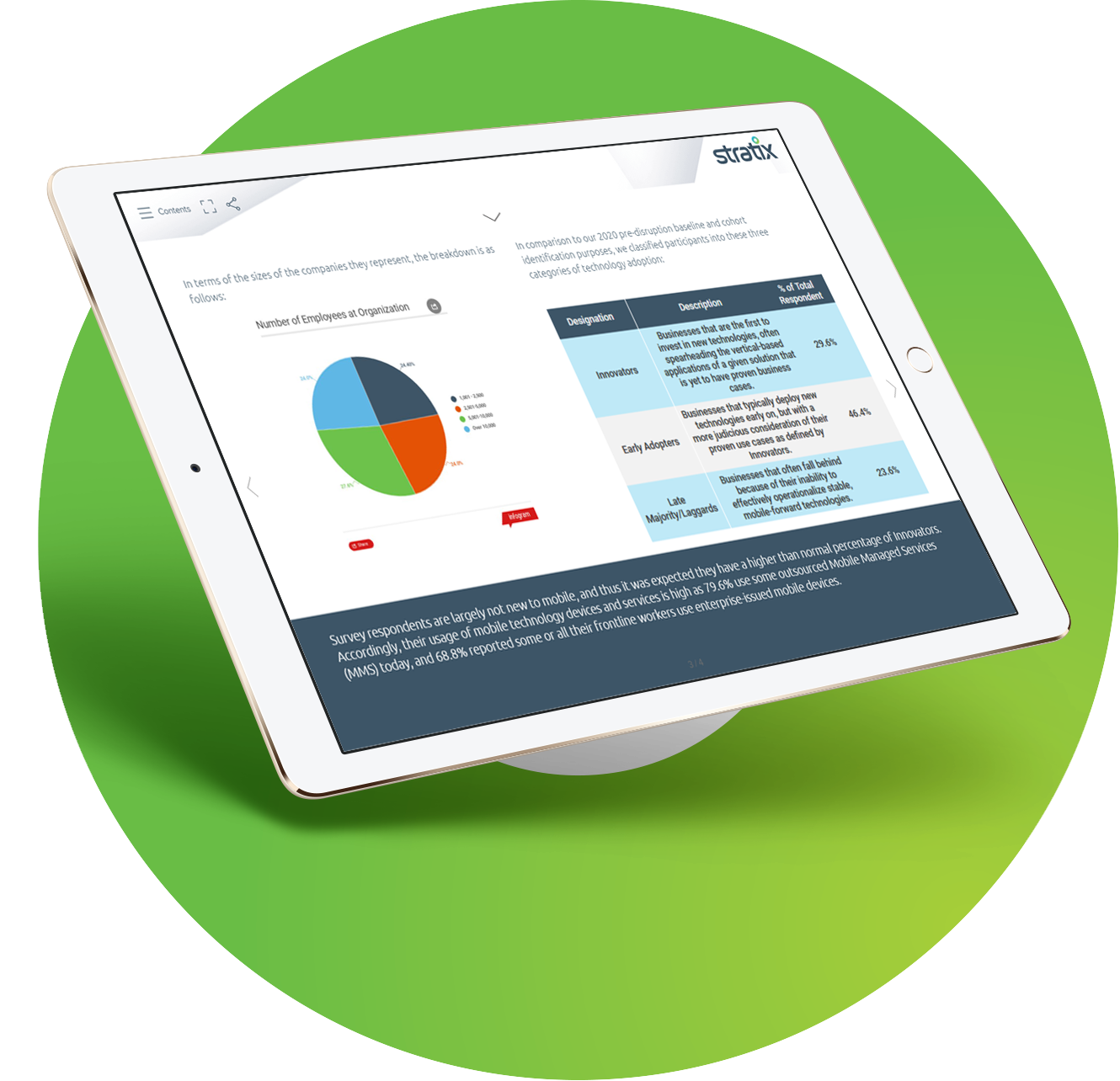Top 3 Post-COVID Tech Investments for Enterprises & Frontline Workers
Written by Elizabeth Klingseisen
2 Min Read
Blog
If 2020 was the year of adjustments to the normal operations of enterprises, 2021 is the year of meeting the customer where they are. No facet of business operations is more important to this principle than frontline workers. From retail store associates to field service personnel, frontline workers have taken precedence in protecting a business’ brand and ensuring a satisfactory customer experience.
In a recent survey by VDC Research, prominent enterprise IT decision-makers were queried about their technology investment priorities both before and after the novel coronavirus outbreak of 2020. Their answers reveal what the “new normal” of enterprise technology deployments looks like and how it will impact frontline workers.
The survey results, summarized in the Stratix report, “2021 Enterprise Mobility Outlook,” are enlightening. Prior to the pandemic, survey respondents ranked cloud-based IT infrastructure and cybersecurity solutions as their top two priorities for technology investments. After the onset of the pandemic, a new set of priorities emerged …
1. Contactless Is Here to Stay
The survey’s most agreed-upon area of investment — both in terms of having been implemented since COVID-19 and explored in response — was contactless mobile technology for customers. While the pandemic has produced a surge in curbside shopping, buy online pick-up in store (BOPIS) and delivery due to health and safety concerns, the larger trend driving the demand for these and other use cases is convenience.
Consumers have grown to understand that contactless shopping and payment models produce a virtually frictionless experience that makes research, purchases and loyalty rewards easier to manage than ever before. Picking the right mobile technology is key in creating a safe environment for both customers and employees in this new landscape and in keeping those devices supported and running.
2. What’s Good for the Customer Is Good for the Frontline Worker
Given that contactless mobile technology was the primary area of investments after COVID-19, it only makes sense that enterprises’ secondary priority was mobile devices and apps for their frontline workers. In fact, since the onset of the pandemic, enterprise smartphone usage has actually outpaced laptop, desktop and tablet usage. Just as there are myriad benefits beyond health and safety for customers, equipping frontline workers with optimal mobile technology devices, apps and support yields multiple rewards.
This new “deskless workforce” is defined by how employees use mobile apps and devices to leverage critical support information, comprehensive product/customer data and connectivity whenever they need it most. Gains in efficiency, productivity and customer satisfaction naturally follow.
The increased reliance on mobile devices, though, has also produced challenges. In a recent research survey by B2M Solutions, two-thirds of frontline workers reported experiencing mobile issues that impaired their ability to do their jobs. For example:
- 70% had to deal with poor or unstable connectivity.
- 62% said the mobile apps they use often crash.
- 48% of IT managers admitted to an increase in the number of worker-reported issues in the previous 12 to 18 months.
Perhaps the most sobering finding was that 85% of monthly mobile issues go unreported to IT, up five percentage points from the prior year. This is a huge liability that may present multiple bottlenecks to enterprise operations when businesses can least afford further disruptions and downtime. It is also a clear indication that as the complexity of mobile technology deployments grow, so too will the need for a comprehensive managed mobility support infrastructure to bolster existing IT support resources.
3. Revving Up Remote Work
The third-most popular area of investment for survey respondents was workforce collaboration. This was a natural response to many workforces having to go largely, if not entirely, remote. However, there is an enduring appeal to making these tools and underlying platforms a centerpiece of enterprise IT strategy.
Workplaces will only become more flexible as companies recognize the need for employees to work safely, productively and effectively from anywhere. This means providing employees with the right devices, services and collaboration tools. In an environment where they have less face-to-face time with their teams than ever, it will be more crucial than ever for employees to stay connected and informed.
Prepare for a Mobile-First Future
With growing numbers of organizations making technology investments to accommodate employees working outside of the office and to service their customers, business is clearly becoming more mobile-centric. What does this mean for your enterprise? As the Stratix report states, “Strong, flexible mobile IT infrastructure will be the foundation for enterprise success, both as an important investment in preparing for disruption and also as a key figure in their frontline workers being able to take advantage and thrive during and immediately after widespread disruption.”
To learn more — and prepare your organization for a mobile-first future — download the “2021 Enterprise Mobility Outlook” now.

2021 Enterprise Mobility Outlook
Stratix and VDC Research surveyed hundreds of IT decision-makers to see how they adapted and thrived amidst disruption through mobile first strategies.
Get the Report













